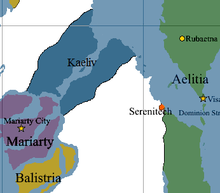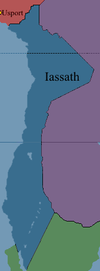Nation/Kaeliv
| This page is a work in progress by its author(s) and should not be considered final. |
| Imperial Iassathi Republic of Kaeliv Aftokratorikí Iasáti Dimokratía tou Iotárno
|
||||
|---|---|---|---|---|
|
||||
| Motto: The beacon of light in the darkness. | ||||
Kaeliv and nearby nations.
|
||||
| Capital and largest city | Al-Qurrani | |||
| Official languages | Codexian Iassathi |
|||
| Ethnic groups | 57.6% Human 32.7% Vulpine 6.3% Lupine 3.8% Other |
|||
| Demonym | Kaelivian | |||
| Government | Unitary Presidential Republic | |||
| - | Imperial Exarch | Justinian Kalivas | ||
| - | Imperator | Constantine Palamaras | ||
| Legislature | Synédrio | |||
| - | Upper house | Gerousía | ||
| - | Lower house | Voulí ton Antiprosópon | ||
| Population | ||||
| - | 2017 estimate | 37,978,364 | ||
| - | 2015 census | 37,882,985 | ||
| GDP (nominal) | estimate | |||
| - | Total | $847,437,736,852 | ||
| - | Per capita | $22,369.00 | ||
| Currency | Rohorin (KAR) |
|||
The Imperial Iassathi Republic of Kaeliv, also known as Kaeliv, is a unitary republic located in Northern Arcturia. Kaeliv is composed of twelve exarchates and one imperial exarchate which get their powers from the central government. Kaeliv doesn't border any nation directly but Balistria and Mariarty are just to its southwest and Aelitia and a Serenitech outpost are to its east. Kaeliv is a Unitary presidential republic with a two-house legislature. The current Imperial Exarch is Justinian Kalivas, who was elected on December 1st 2005 and began his first term on January 1st 2006. He is currently serving his 6th and final term. The capital and largest city of Kaeliv is Al-Qurrani, which is also the home of many industries in Kaeliv.
History
Ancient Kaeliv
Ancient Kaeliv refers to the time before the area where Kaeliv is was colonized. Before the colonizers from Iassath came, the natives inhabited the thick jungles in various tribes. Not much is known about them however as they kept no records and the records that were kept were lost once Iassath collapsed. What we do know about them however, is that they were not large in number and most lived in the thick jungles towards the interior. Remains that have been found suggested that they were shorter than the average human at the time, but not short enough to suggest they were pygmies. No structures have been found either. However, some artifacts such as stone spears, axes, and other tools have been found.
Colonial Kaeliv
The first colonizers from Iassath came to Kaeliv in the early 1580's. They arrived on the northern side of the strait and set up a trading outpost. True colonization didn't begin until the late 1590's when gold and gemstones were discovered further inland. This brought the settlers into conflict with the natives. At first the natives welcomed the settlers in. That is, until the natives started to die of disease.
When the natives started to get sick and die, the remaining natives forced the settlers out. Outraged, Iassath sent soldiers into the jungle to fight the natives. The natives, being accustomed to the jungle, were able to use guerilla warfare against the larger and better armed armies. As time went on though, the armies of Iassath were able to overcome the natives and kill them. With the natives gone, the settlers were free to colonize the land.
In the early 1730's, tragedy struck Iassath and the nation collapsed, destroying many historical records and leaving behind Kaeliv, then known as New Iassath. The settlers initially panicked, as they had just been stranded. The governer of New Iassath at the time, named Anastasius Zografos, took power and stabilized the colony, which he renamed Kaeliv. His first act as Imperial Exarch was to declare Kaeliv an independent country in 1735. Later, he shrunk the borders to their modern day size in order to better control the country and set up a government for Kaeliv. He was so well loved by the people that he was elected for 6, two year terms, which he made the limit for how long an Imperial Exarch could serve.
Modern Kaeliv
(WIP)




